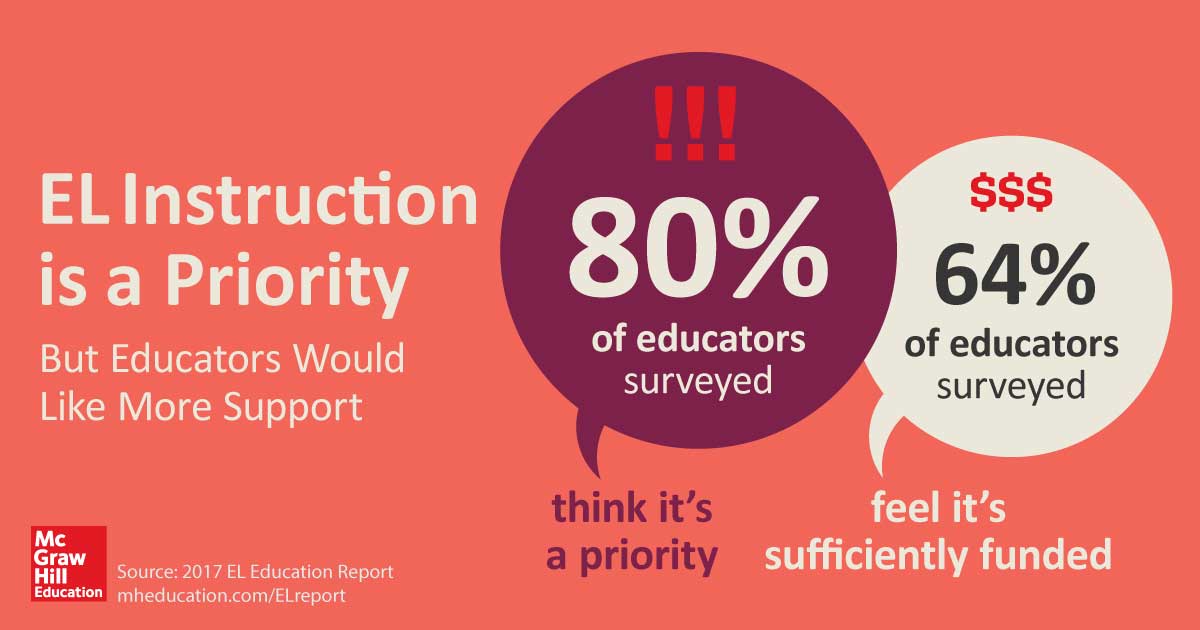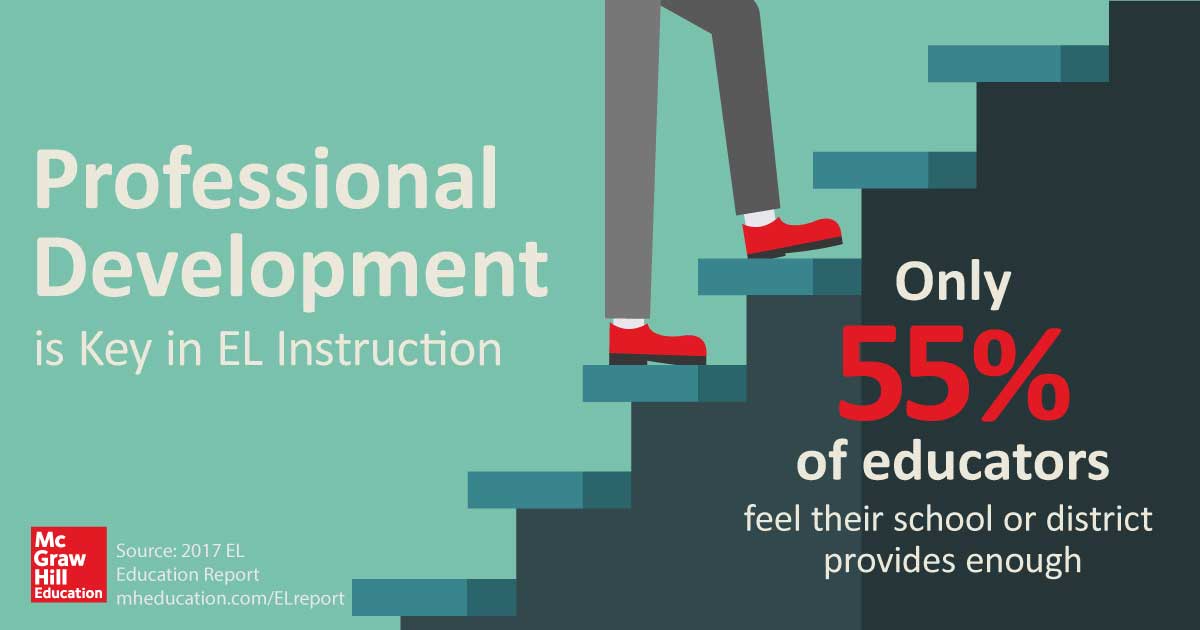K-12 Educator Survey Results: Rising Need for English Learner Instruction Will Require More Resources and Professional Development
According to a new survey by McGraw-Hill Education, educators see EL enrollment increasing steadily in their schools or districts, particularly in the Northeast, Midwest and Southern regions versus the West
Nov 29, 2017
NEW YORK, Nov. 29, 2017 /PRNewswire/ -- As the demand for English Learner (EL) instruction grows across the United States, the vast majority of K-12 educators (80 percent) believe EL instruction is a priority for their school or district, according to the results of the 2017 EL Education Report, a new survey conducted by learning science company McGraw-Hill Education. Educators also indicate that more professional development and different types of learning materials are needed to meet the needs of EL students.
Experience the interactive Multichannel News Release here: https://www.multivu.com/players/English/7782355-mcgraw-hill-education-english-learner-survey/

According to the survey results, educators see EL enrollment increasing steadily in their schools or districts, with more rapid growth in the Northeast, Midwest and Southern regions compared to the West. Of the languages spoken by EL students in the classroom, educators report that Spanish continues to be the most common. Educators also report that they have EL students who speak Arabic, Mandarin, Vietnamese, Tagalog and Russian among many others, indicating ongoing demand for EL instruction that accommodates a diverse group of students and languages spoken in the classroom. To download and read the full report, visit mheducation.com/ELreport.
"EL students make up one of the fastest-growing student populations in the United States, and educators and school leaders have to think differently about how to meet their needs," said Heath Morrison, President of McGraw-Hill Education's School Group. "With the diverse demographics of today's student population, it is imperative that educators have access to ongoing professional development and training, as well as a robust array of resources to accommodate the diverse needs of EL students and to help them succeed in the classroom and beyond."
More Room for Professional Development to Support EL Student Success
Professional development is widely recognized as being critical for supporting the success of EL educators and students, and most EL educators would like to see more of it.
- Ninety-nine percent of respondents believe professional development for teachers and staff members is essential for effective EL instruction. However, only 55 percent of respondents believe that their school or district provides sufficient, ongoing professional development to support EL student success.
- Only 39 percent of teachers and administrators strongly agree they have received sufficient EL training and professional development, and 82 percent of all respondents indicate that they are spending their own personal time and effort to develop their skills to meet their EL students' needs.
- Newer EL educators (those who have worked in EL education for less than two years) are significantly less confident than more experienced educators in their EL training and development, with only 36 percent of new respondents feeling they have received enough professional development compared to 70 percent of more experienced educators.
Digital and Adaptive Learning Tools Viewed as Most Effective for EL Instruction
With diverse language, cultural and educational backgrounds of EL students, teachers continue to use curated and customized learning materials, which can be more time-consuming and challenging to develop.
- A large percentage of respondents believe that digital materials, including video and audio resources, and adaptive learning technologies are among the most effective for EL instruction (92 percent and 87 percent of respondents, respectively), compared to printed workbooks and textbooks (67 percent and 61 percent of respondents, respectively).
- Free online educational resources are among the most common instructional resources used for EL instruction (used by 63 percent of educators), followed by video and audio (59 percent) and textbooks (59 percent).
- Despite the perceived higher efficacy of adaptive learning tools, fewer than half of the respondents currently use adaptive learning technologies (44 percent).
Parental Engagement and Family Support Rank among Most Important Factors for EL Success
Strong family engagement is believed to have a huge impact on EL students' academic success, particularly in the areas of motivation and commitment.
- Ninety-nine percent of respondents rank family support and engagement as being extremely or very important to EL students' success.
- However, less than 50 percent of educators feel that EL students have parental support in learning English, and 74 percent of respondents believe that the parents of the majority of EL students in their schools are learning English themselves.
- In addition, only 30 percent of respondents agree that students have access to EL materials at home.
The survey also shows that while the majority of respondents believe that EL instruction helps students become more proficient in English (93 percent), they are less likely to agree that EL instruction is helping students become career or college ready (84 percent and 79 percent respectively).
"Nearly 90 percent of the respondents in our survey are optimistic about the continued improvement in EL students' academic performance," added Morrison. "At the same time, we see opportunities to provide stronger support to teachers and students, while also finding new ways to help schools engage parents and families at home."
About the 2017 EL Education Report
McGraw-Hill Education's 2017 EL Education Report was administered by Hanover Research to more than 1300 teachers and administrators across the United States to examine the opinions of teachers and administrators in K-12 schools regarding English Learner (EL) instruction. Seventy-six percent of the respondents indicated that EL instruction is a core responsibility. The study assesses EL instructional approaches and material preferences, as well as perceptions, challenges and opportunities. In this press release, results are for all respondents (teachers and administrators), unless specifically indicated as from teachers.
About McGraw-Hill Education
McGraw-Hill Education is a learning science company that delivers personalized learning experiences that help students, parents, educators and professionals drive results. McGraw-Hill Education has offices across North America, India, China, Europe, the Middle East and South America, and makes its learning solutions available in more than 60 languages. Visit us at mheducation.com or find us on Facebook or Twitter.
Contact:
Nina Chang
McGraw-Hill Education
(646) 766-3055
nina.chang@mheducation.com



SOURCE McGraw-Hill Education
